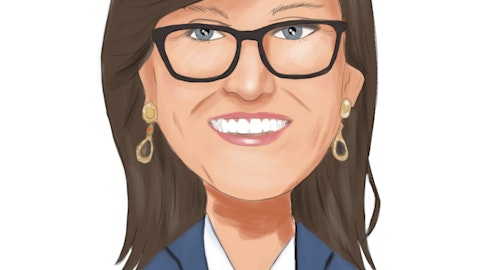Jason Robins: So for us, a lot of the questions around branding and product were still in the early stages. But the current plan is to keep it as its own brand and app. I think they’ve built a strong audience and a good brand, and I think that we want to keep it, but obviously we’re going to explore opportunities to integrate ecosystems, have all products available across all brands, just like we do with GNOG. And I think Jackpocket has a casino that they — so there’s a lot to do there, I think, with their brand, and we’ll see how that all evolves over time, but that’s the current plan. And then I’m sorry, what was the second question?
Stephen Grambling: Does the target — as you look out to 2026 on [Multiple Speakers] including states.
Jason Robins: Yes. So no new OSB and iGaming states are included in our synergy or any other assumptions. So we’re just assuming current footprint. So a lot of upside if there’s more OSB and iGaming states and cross-selling more customers, we do assume that some more lottery states launch. As I noted earlier, it’s a lot more seamless to launch a lottery state. You don’t need to go through the legislative process. It’s really more of going and working out a deal directly with the state. So I think that, that’s something that we feel a lot of confidence in and if you look at their ramp over the last few years, they’ve launched a number of different states. And I think the hardest part really is — because there’s no legislative process.
The hardest part is, one they’ve already solved, which is, building a technology solution that will scale and we’ll be able to service multiple states and lots of customers at the same time. And of course, remember, there’s already states that they’re in, that are big states. I mean, Texas is a huge revenue state for them. And as we know, Texas came very close last year to passing OSB, and we’re very hopeful they will this year. New York is a huge state for them. I think New York could do iGaming in the next year or so. So that’s another big opportunity. So really, I think the best is yet to come. And as I said earlier, this is an asset that we believe will just continue to increase in value, because if you’re a believer, which I hope we all are, that there will be more and more OSB and iGaming states, none of that is baked into any of our synergy assumptions, that’s just all upside.
Stephen Grambling: That’s super helpful. And maybe looping in Jason Park here on free cash flow. As we look further out, how do you generally anticipate free cash flow conversion evolving?
Jason Park: Yes. So we outlined that for 2024, the free cash flow — the delta between adjusted EBITDA and free cash flow, net impact of CapEx, cap software plus some cumulative good guides across working capital and interest income. It’s about $100 million. So that’s a free cash flow yield on the adjusted EBITDA. I think about the components between adjusted EBITDA and free cash flow as being more steady over time. So as adjusted EBITDA grows, the free cash flow conversion percentage is going to go up, Stephen.
Stephen Grambling: Perfect. Thanks so much. We are going to be back in.
Jason Robins: You got it.
Operator: Thank you. Our next question comes from Bernie McTernan with Needham & Company. Your line is open.
Bernard McTernan: Great. Thanks for taking the question. Just to start, Jason, in the letter, you said 87% customer retention over a five year period on average. I think that was better than what was quoted in the Investor Day a couple of years ago. Is that true that retention is improving that much? Or the numbers not apples-to-apples?
Jason Robins: Yes, I think that is true. I mean I’m not sure if it’s exactly apples to apples, I have to go back and check. But absolutely, retention is improving.
Bernard McTernan: Okay. Any drivers to call specifically.
Jason Robins: Yes. I mean I think it’s largely product. That’s the biggest one. I also think that you’re just seeing more and more natural organic growth as customers adopt more sports and things like that, which just keeps them more sticky and active on the product. But it’s really just the product advancement more than anything else. We also are constantly optimizing our CRM. So that’s a big lever too. I should mention we’re testing all the time and finding wins. So I think between the product improving greatly over the last couple of years and our marketing and team continuing to test and learn the biggest drivers. But there’s a lot of things, right? I think our customer service has improved. We’re — I think there’s so many different dimensions across the products and across the entire customer experience that have helped us improve our retention.
Bernard McTernan: Great. And I know it’s early days, but just wanted to get your thoughts on [Barstool] (ph) and what that could be as a customer acquisition and retention vehicle for you guys.
Jason Robins: We’re very excited about that when we worked with Barstool many times over the years and really thrilled to be working with them again. It’s a partner that we know very well and I have a ton of data on. So we felt really — I mean, this is about as good as it gets in terms of us having historical data and being able to underwrite this deal. So it’s really exciting, and we believe it will be a strong performer for us.
Bernard McTernan: Great. Thanks, Jason.
Operator: Thank you. Our next question comes from Chad Beynon with Macquarie. Your line is open.





